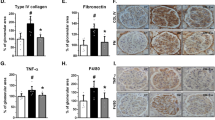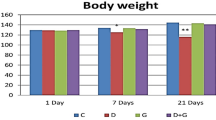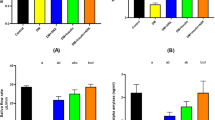Abstract
Jiménez Díaz, Grande Covián and De Oya1 have reported that in dogs in which the vessels of both kidneys were clamped, the intravenous injection of alloxan in doses of 80–100 mgm./kgm. failed to produce either the hyperglycæmia or uræmia observed in controls in which the clamping was omitted. They postulated that "contact between alloxan and the kidney is apparently necessary for the display of the full diabetogenic effect". However, diabetes was observed on injecting alloxan during clamping of both renal pedicles in rats2,3 and rabbits4. Recently, Jiménez Díaz and Souto Candeira5 postulated that "alloxan produces some kind of renal injury which accentuates diabetes. . . . In conclusion, the kidney is apparently not necessary for the production of alloxan diabetes, but renal injury produced by alloxan Would contribute to accentuate it."
This is a preview of subscription content, access via your institution
Access options
Subscribe to this journal
Receive 51 print issues and online access
$199.00 per year
only $3.90 per issue
Buy this article
- Purchase on SpringerLink
- Instant access to full article PDF
Prices may be subject to local taxes which are calculated during checkout
Similar content being viewed by others
References
Jiménez Díaz, C., De Oya, J. C., and Grande Covián, F., Rev. Clín. Espanola, 21, 328 (1946); Nature, 158, 589 (1946).
Gold, A., Nature, 159, 574 (1947).
Martínez, C., Gitter, S., and Covián, M. R., Rev. Soc. argent. Biol., 23, 81 (1947).
Duff, G. L., Wilson, D. C., and McMillan, C. C., Nature, 159, 575 (1947).
Jiménez Díaz, C., and Souto Candeira, J., Rev. Clín. Espanola, 27, 335 (1947).
Author information
Authors and Affiliations
Rights and permissions
About this article
Cite this article
HOUSSAY, B., MARTÍNEZ, C. Alloxan Diabetes in Dogs with Renal Pedicles Clamped. Nature 162, 571 (1948). https://doi.org/10.1038/162571a0
Issue date:
DOI: https://doi.org/10.1038/162571a0



